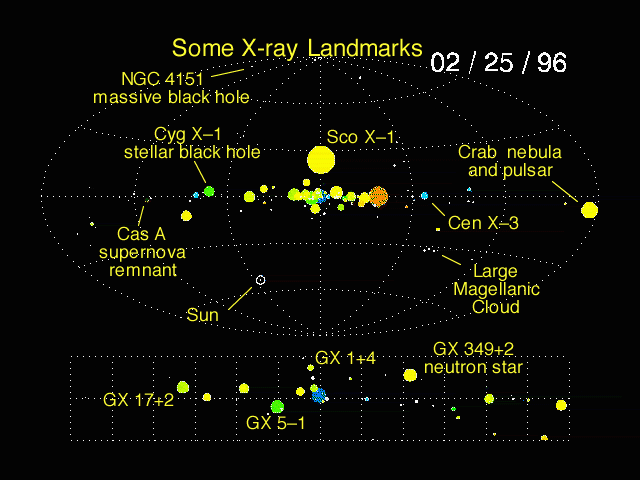RXTE Discoveries
ASM Video Reveals the Violent X-ray Sky: MIT Video showcases data from Rossi X-ray Timing Explorer satellite - April 2000
If you could view the night sky with X-ray sensitive eyes, you would see a turbulent sky filled with dying stars, active quasars and the enormous temperatures produced by matter being sucked into massive black holes at mind-boggling speeds.
An animated video released by Massachusetts Institute of Technology researchers at the annual meeting of the American Astronomical Society (AAS) this past January reveals this changing and turbulent X-ray sky during the past four years.
The animation depicts X-ray objects on a map of the entire sky. The X-ray objects are pinpoints, just like visible stars, but in the animation they are indicated with colored circles. The size of a circle represents the brightness. The color of the circle is the "X-ray color:" Blue generally represents higher-temperature gases and red represents lower-temperature gases.
Watching the X-ray Sky ...
The animation runs about 350,000 times faster than actual time. Four days of time pass in about one second, and the entire four years passes by in around seven minutes. The rectangular image below the sky image is a magnification of the center of our Milky Way galaxy, which has a high density of X-ray stars.
One section of the animation, covering April 30, 1999 to June 30, 1999, shows the microquasar GRS 1915+10 as it varies erratically in its temperature and brightness. It also shows Scorpius X-1, the brightest X-ray source in the sky, and Circinus X-1, a binary system consisting of a normal star and a neutron star in a 16-day orbit. Show me this section of the animation !
Another section of the animation depicts the x-ray sky from March 2, 1996 through May 11, 1996; and then again from August 26, 1996 through October 15, 1996. This clip depicts a number of variable x-ray objects near the center of our galaxy, including the Bursting Pulsar, 4U 1630-47 and Nova Sco 1994. To provide a contrast, it ends by highlighting two steady sources - the Crab Nebula and Cassiopeia A, which are both remnants of exploded stars. Show me this second section of the animation !
The video was presented at the AAS meeting by Hale Bradt,a professor of physics at MIT and co-recipient of the Rossi Prize of the High Energy Astrophysics Division of the AAS for his role in the RXTE project. Professor Bradt received help preparing the video from MIT graduate student Michael Muno, postdoctoral associate Donald Smith, and Alan Levine and Ronald Remillard, principal research scientists at MIT's Center for Space Research and Robin Corbet of NASA's Goddard Space Flight Center.
The All-Sky Monitor (ASM) experiment on the RXTE satellite provides data on about 150 X-ray sources for the animation. X-ray cameras in space like the Rossi are our window to these extremely energetic and often violent processes in the universe. The seven-minute video "demonstrates dramatically the extreme brightening, fading, disappearances and sudden appearances of these stars from 1996 to 1999," Bradt said. "By contrast, the visible sky we usually see is relatively unchanging and seemingly quite peaceful."
Changes in energy output, or brightness, may be due to unstable winds of gas from the donor star in a binary star system. Changes also may be caused by instabilities in the disk of whirling gas surrounding the neutron star or black hole. "It is the objective of scientists studying the data from RXTE to better understand these processes, which cannot be duplicated on Earth," Bradt said.
The Astronomy Community's use of the ASM Data
Scientists at MIT and GSFC use data from the ASM to calculate the intensities of the 150 sources in near real time. The data are immediately made available to the public, so scientists using RXTE or other observatories such as the Italian BeppoSAX or the recently launched NASA Chandra Observatory will know the state of X-ray sources they may wish to study.
"The ASM data reveal the existence of previously unknown sources, alert astronomers to new types of behaviors and help us understand the energetic processes in the sources, such as the creation of jets of material being ejected from black holes," Bradt said.
The ASM's resolution in time and angle far exceeds that of the only other X-ray experiment that lead to an X-ray movie of the whole sky, which was created in the 1970s by William Priedhorsky and James Terrell of the Los Alamos National Laboratory with data from the Vela B satellite. An animation of the more restricted region at the center of our galaxy was released last June. It was constructed with data from another instrument on the Rossi satellite by Craig Markwardt and Frank Marshall of NASA's GSFC.
Go to the the full-length animation on the MIT XTE web site



